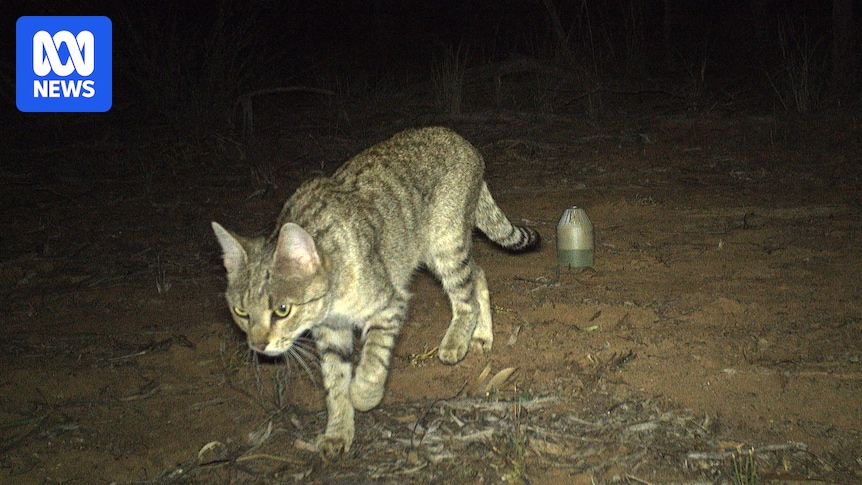The NSW government will recruit a team of expert shooters in a state-first program to remove feral cats from national parks.
The National Parks and Wildlife Service’s (NPWS) first-ever dedicated feral cat control team will be based in either Dubbo, Bourke or Broken Hill in an attempt to control the invasive mammal from parks throughout the west of the state.
The NSW Department of Environment and Heritage estimates feral cats kill 1.5 billion native animal nationally per year — and the NPWS said its staff have reported an increase in native animal deaths, particularly in central and western NSW.
An estimated 1.5 billion native animals are killed by feral cats every year in Australia. (NSW Environment and Heritage)
“We’ve taken this extra step to attempt to reduce their impacts,” director of the west branch of NSW NPWS, Darren Pitt, said.
He said it was hoped the landscape of the west would make ground shooting an effective control method.
“[The terrain has] a bit of visibility, not as much canopy as you might have on the mountainous areas towards the east coast,” he said.
While the shooting of feral cats is permitted in all states and territories within Australia, this is the first time a dedicated feral cat control team has been assigned by the state government.
Dusky hopping mice are among the many prey animals to feral cats. (Thomas Hunt)
NPWS estimates there are 6.3 million feral cats across Australia, however only those within national parks will be targeted in the initial two-year program, which may be expanded to other areas if successful.
Mr Pitt said that while the full eradication of feral cats was not possible, keeping their numbers as low as possible was necessary for the conservation of native wildlife.
“Feral cats must catch and kill something for every meal … and they certainly prefer live prey,” he said.
“[That’s about] 700 small mammals, birds, reptiles one cat can kill in a year.”
Mr Pitt said species like dusky mice, smaller yellow-footed rock wallabies and ground nesting birds such as the plains wanderer and reptiles like the endangered Barrier Range dragon were at risk from feral cats.
Grey grasswrens often fall victim to feral predators. (Jeff Hardy)
How does it work?
NPWS already conducts a number of different control measures for cats and other feral animals throughout its parks.
Baits are laid, and the service uses camera traps to collect data on where there might be an increase in feral cat activity or an increase in a particular threatened species at risk from cats.
Native rats are another species regularly targeted by feral cats. (National Parks and Wildlife Service)
“We’ll have those targeted to those sites to make sure we are getting bang for our buck,” Mr Pitt said.
Is ground shooting effective?
Jack Gough is advocacy manager with the Invasive Species Council. (Supplied: Jack Gough)
Advocacy director of the Invasive Species Council Jack Gough said ground shooting was a good option to combat cats’ stealthiness.
“Cats can be quite good at hiding … they can be very smart, and they can evade trapping,” Mr Gough said.
“We know that when [ground shooting is] used in conjunction with other methods including baiting, trapping, and some of the AI tools that are available … these can be an important way to reduce the pressure of feral cats in the landscape.”
NPWS said shooters are highly trained and follow best-practice protocols to ensure the culling was done humanely.
Barrier Range dragons have significantly decreased in population over recent years. (Matthew Bonnett DCCEEW)
“They use equipment that is high quality and appropriate for the task,” Mr Pitt said.
“Shooters will not shoot unless the target area is clearly visible and they are confident that a rapid death will occur.”
Are pet cats at risk?
While the program does not target pet cats, Mr Pitt said they should not be in a national park regardless.
“The general call for responsible pet ownership is needed,” he said.
“Pet cats are generally well looked after, but they still will hunt and kill animals even if they’re not hungry.
“If there’s a cat in a national park, unless it’s really identifiable as someone’s pet cat, it would be in trouble.”
